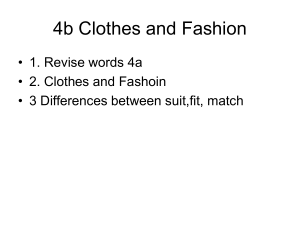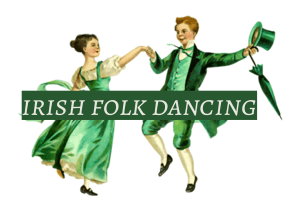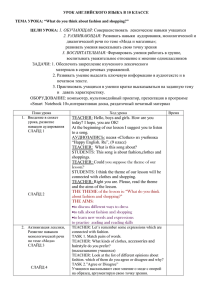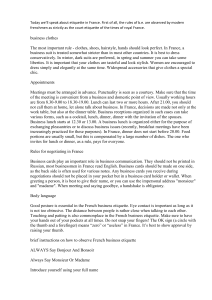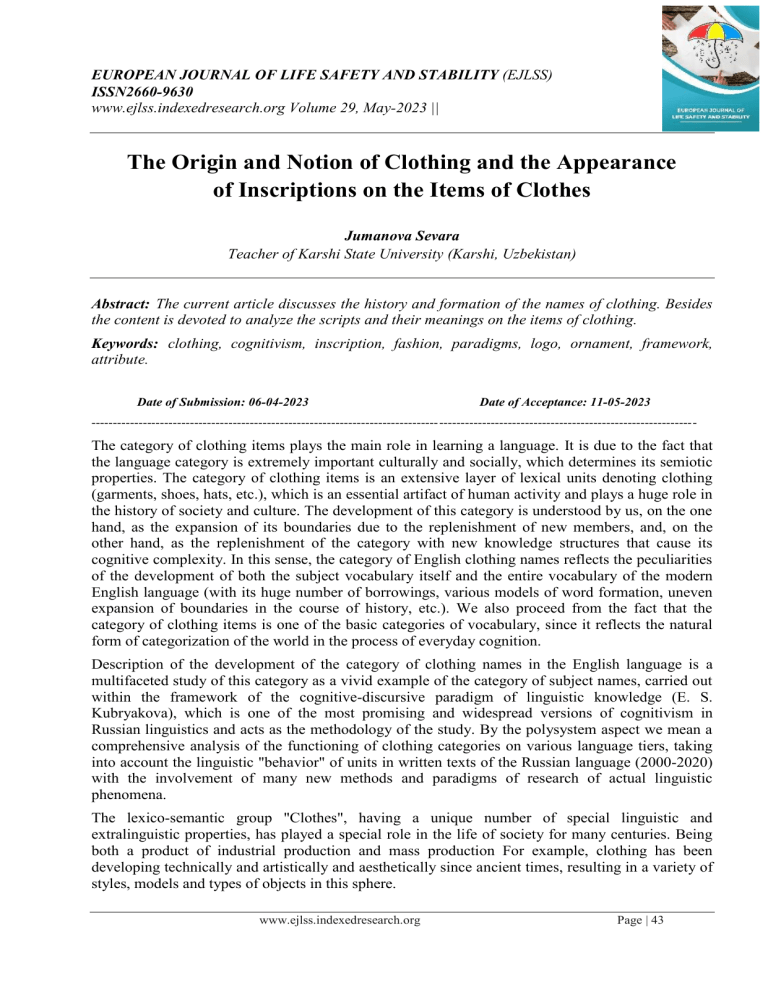
EUROPEAN JOURNAL OF LIFE SAFETY AND STABILITY (EJLSS) ISSN2660-9630 www.ejlss.indexedresearch.org Volume 29, May-2023 || The Origin and Notion of Clothing and the Appearance of Inscriptions on the Items of Clothes Jumanova Sevara Teacher of Karshi State University (Karshi, Uzbekistan) Abstract: The current article discusses the history and formation of the names of clothing. Besides the content is devoted to analyze the scripts and their meanings on the items of clothing. Keywords: clothing, cognitivism, inscription, fashion, paradigms, logo, ornament, framework, attribute. Date of Submission: 06-04-2023 Date of Acceptance: 11-05-2023 --------------------------------------------------------------------------------------------------------------------------------------------- The category of clothing items plays the main role in learning a language. It is due to the fact that the language category is extremely important culturally and socially, which determines its semiotic properties. The category of clothing items is an extensive layer of lexical units denoting clothing (garments, shoes, hats, etc.), which is an essential artifact of human activity and plays a huge role in the history of society and culture. The development of this category is understood by us, on the one hand, as the expansion of its boundaries due to the replenishment of new members, and, on the other hand, as the replenishment of the category with new knowledge structures that cause its cognitive complexity. In this sense, the category of English clothing names reflects the peculiarities of the development of both the subject vocabulary itself and the entire vocabulary of the modern English language (with its huge number of borrowings, various models of word formation, uneven expansion of boundaries in the course of history, etc.). We also proceed from the fact that the category of clothing items is one of the basic categories of vocabulary, since it reflects the natural form of categorization of the world in the process of everyday cognition. Description of the development of the category of clothing names in the English language is a multifaceted study of this category as a vivid example of the category of subject names, carried out within the framework of the cognitive-discursive paradigm of linguistic knowledge (E. S. Kubryakova), which is one of the most promising and widespread versions of cognitivism in Russian linguistics and acts as the methodology of the study. By the polysystem aspect we mean a comprehensive analysis of the functioning of clothing categories on various language tiers, taking into account the linguistic "behavior" of units in written texts of the Russian language (2000-2020) with the involvement of many new methods and paradigms of research of actual linguistic phenomena. The lexico-semantic group "Clothes", having a unique number of special linguistic and extralinguistic properties, has played a special role in the life of society for many centuries. Being both a product of industrial production and mass production For example, clothing has been developing technically and artistically and aesthetically since ancient times, resulting in a variety of styles, models and types of objects in this sphere. www.ejlss.indexedresearch.org Page | 43 European Journal of Life Safety and Stability It’s impossible to imagine modern teenagers without such attributes as cell phones, walkman, jeans, and, of course, T-shirts with a logo or inscription. Today the youth, as in a mirror, reflects new trends, current problems and the public interest. Nowadays different inscriptions on youth’s clothes serve as an essential attribute. They can tell us a lot about a person, in particular, the age, the level of knowledge of English and the interests of its owners. And quite a lot of young people do not fully understand the meaning of inscriptions written in English. However, they wear such clothes because they are fashionable, beautiful or maybe there are some other reasons for it. Most pupils and students do not pay much attention to inscriptions on their clothes, which in their turn can contain rude words, grammar and spelling mistakes. Inscriptions on clothes existed many centuries ago. The earliest are familiar to us since Ancient Greece. There we can find embroideries on belts which tell us the names of the owner, or we can find names on jewelry. On a set of Italian and German portraits of the end of XV and XVI centuries you can meet inscriptions which are interwoven into an ornament of men's shirts, into corsages of women's dresses. They are usually written in Latin and contain mottoes of noble families or the names of owners of these portraits or dresses. There always were many inscriptions of a very provocative character on women's garters. Very often inscriptions which represented a part of an ornament were fashionable. For example, at the beginning of the second millennium Gothic fonts were used in embroidery. Pelerines of the king Otto which are in the museum in Germany are quite well - known. There in storage of the cathedral there are surprising things with Gothic or Romance letters - as a part of an ornament of these ancient embroideries. They are dated from X-XI centuries of our era. We can find the mass of ornaments in jewelry where letters and phrases are interwoven into drawings. We can find it at Celts where letters play a huge role; we can also find it in ancient Slavic jewelry where words are part of a jeweler ligature too. It all began very simply: at first inscriptions decorated only the uniform of workers, indicating their status on a workplace. Then they began to show what designer or what firm this thing belonged to, and after it inscriptions which really bear sense began to appear. It isn't known who thought up the first to write inscriptions on clothes. You shouldn't think that inscriptions on clothes are the exclusive invention of mass street fashion, many venerable couturiers didn't avoid this means of expression. Franco Moschino was the biggest "hooligan" in the Italian fashion. The best-known models of Moschino are a suit with an inscription on a waist "A waist of money" (it is possible to read it as "The wasted money" — it fell to pieces on the client exactly in a week), a dress - a plastic package, a hat-plane and a hat-hanger. The success to Moschino was brought by models with inscriptions and accessories with the gold volume letters "MOSCHINO" - bags and belts. Texts of inscriptions were ironic and gave new sense to classical dress code. Moschino understood that it is impossible to treat fashion too seriously, thus his clients often turned into "walking advertising" of the Moschino brand, wearing jumpers, dresses, hats, bags and belts with his name. Moschino turned the small label sewn from a wrong side into huge slogans on the most visible and unexpected places. The collection of 1955 of Christian Dior was created on three letters - H, A and Y. All dresses had such outlines, and their stitches repeated these three letters. They were the most fashionable collections in the season of 1955 – it was just the moment when young Yves Saint Laurent came to Dior. Perhaps, the letter Y also symbolized Yves's arrival. In 1985 for "The Russian collection" fall/winter of 1986 — 1987 Jean Paul Gautier created the models decorated with inscriptions with the use of Cyrillics. This surprising collection included Slavic letters - Cyrillics, he wrote them on the clothes in an ornament "Jean Paul Gautier". It was a hit, all French dandies wore things with this logo, and especially they liked the letter ―J‖ because it is similar to a bug or to some Chinese ornament. Then Cyrillics became fashionable in general, Slavic letters were used in the second half of the 80th years in jersey, sweaters, jackets, in many www.ejlss.indexedresearch.org Page | 44 European Journal of Life Safety and Stability accessories. Now we can meet it too: for example, many designers of clothes use stylized letters in the logos of the fashion houses. The mankind will never walk away from using words on clothes as the use of letters allows focusing dreams of dandies on concrete products. Besides, the inscriptions interwoven into an ornament allow learning more about opinions, knowledge, addictions of the one who wears such clothes. As we already noted, t-shirts are the irreplaceable attribute of youth clothes. They can be free and fitting, one-color or with drawings and inscriptions, sports and girlish. We owe the emergence of t-shirts to the American soldiers of World War I. First, the t-shirt was nothing but comfortable underwear from cotton which wasn't planned to be shown. In World War II Americans decided to raise an easy and cheap t-shirt from underwear to a uniform rank. Over time, the t-shirt left a framework of a military uniform and became daily and widespread clothes. The t-shirt with an inscription is a data carrier! And therefore, it can be to the point in various situations. We won't begin to list them, but we will try to look at a t-shirt from another point of view with advantage and benefit for ourselves. The inscription makes the item of clothing original and outstanding. It is known that the brighter the inscription or picture is, the more attention you get from other people. So, choosing a t-shirt with inscriptions be sure to get your portion of attention – you won’t be unnoticed. A cool t-shirt is good not only to shock people around. Such clothes can cause a great number of other emotions. It turns out that clothes with harmless inscriptions causing smiles and laughter can dispose a lot of strangers to us. We can draw the attention and produce a positive impression. In other words, putting on a t-shirt with a cheerful inscription and become a social mixer. T-shirts with suitable inscriptions will help a KVN team, a group of adherents, a sports team or a usual staff of any office to become brighter, more noticeable and, what’s more important, more solid. A carefully chosen inscription strengthens the team spirit of any collective. Inscriptions on shirts can bring money and be effective advertising! Promoters in t-shirts with symbolics or a slogan will draw attention of clients to goods or services better than any column with announcements. Gifts of t-shirts to clients during any action are an advertising which is carried by clients – what can be better? Imitation or fashion? So to say, nowadays it is fashionable to be different from other people, stand out from the crowd! It is not interesting to be ordinary. And are your clothes talking to? Lots of options! Creativity knows no boundaries! From the loud screaming platitudes such as «Rich», «Hero», «Follow me», «Kiss me» and «I love NY» to expressions which thinkers reworked according to our modern life. We are responsible for what is written on our clothes. When children are small, their wardrobe completely belongs to their parents. At this age babies usually do not worry about what they wear. However, the older they get, the more attention they pay to their appearance. Pupils at school appreciate each other’s clothes. So Youth Fashion has its trends and subject to obey its rules. If the inscription on the shirt somehow reflects the sphere of the interests of its owner - it's all right. Generally, the inscriptions on the clothing should be treated carefully. Surrounding people often take them as the words spoken aloud by the master of fashion, which is natural; otherwise there is a question - if you do not know written foreign inscriptions on your clothes why should you pin it on yourself? So, to paraphrase a famous phrase, we can say - we are responsible for what is written on our clothes. www.ejlss.indexedresearch.org Page | 45 European Journal of Life Safety and Stability The inscription on the clothes is not just a decorative element; it is the means of communication, which has a variety of semantic content. Of course, being a product of society, labels on clothes are dynamic, that is, in a state of constant change. Often they reflect some short-term problems, which after some time become irrelevant; they are replaced by new trends in society that are immediately reflected in the inscription on clothes. That is, as can be seen from the above classification, the semantic classification of inscriptions on clothing is very diverse. In addition, the label has a very powerful communicative potential, and therefore the inscriptions should be treated with caution. References: 1. Arnold R. Clothes: short introduction New York: Express 2005.-120P. 2. Бондарчук Г. Г. Наименования одежды и их семиотические функции // С любовью к языку: сб. науч. тр.,посвящ. юбилею Е. С. М.-Воронеж: ИЯ РАН, ВГУ, 2002.-492 с. - С. 188-196. (0,5 п. л.) Кубряковой. - 3. Jakobsen M.V.Semiotics.Fashion.Cognition. New York: Express 2005.-300P. 4. Отамуродова Орзигул Мусаевна 'PROVERBS AND SAYINGS AS REFLECTION OF PEOPLE'S PERCEPTION IN THEIR LIFE' Vol.1 No. 4 (2023) Journal of universal science research 5. Longman Contemprorary Dictionary of English language for advanced learners. 3rd edition. Oxford; 2009.-2081P. www.ejlss.indexedresearch.org Page | 46



